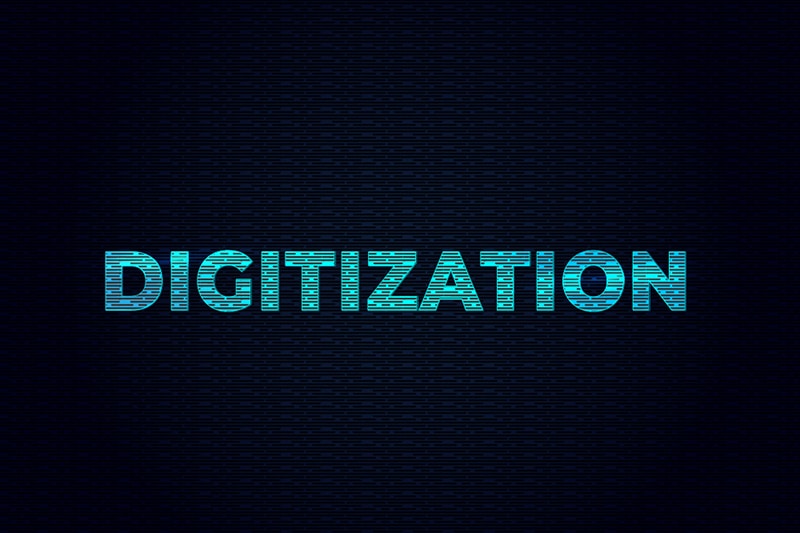Digitization has become ubiquitous, with an increasing number of businesses recognizing its immense potential. Numerous organizations have been compelled to employ data conversion services advanced scanning technology and digitization in order to reduce their use of paper, processing time, and operational expenses. This aids in maximizing their productivity and minimizing their expenses. This trend is especially evident in the paper-intensive processes and physical documentation requirements of the financial, healthcare, and legal sectors.
The business IT sector is expanding quickly, and demand for expert data entry services and digitization across all industries has surged due to technological advancements in cloud adoption, big data, software defined networking, IOT (Internet of Things), virtualization, threat detection, and security. Digital transformation is becoming more than just a fad; it’s now an essential component of any contemporary business plan.
Business Digitization Trends
Cloud Computing
Cloud services are becoming more and more popular because they allow companies to store, access, and manage data and apps from a distance. Scalability, cost-effectiveness, and collaboration are made possible by cloud computing.
Remote Work and Collaboration Tools
The COVID-19 pandemic hastened the shift towards remote work, resulting in a greater dependence on project management software, video conferencing, and virtual communication platforms as collaboration tools.
Artificial Intelligence (AI) and Machine Learning (ML)
Companies are using AI and ML for automation, predictive analytics, data analysis, and improving customer experiences. Virtual assistants, automation tools, and chatbots are more widely used.
Internet of Things (IoT)
IoT is important for tying devices together and gathering information for better decision-making. It is used in a number of sectors, including manufacturing and healthcare.
Cybersecurity Measures
As the world becomes more digitally connected, cybersecurity is becoming more and more important to safeguard private information and uphold consumer confidence. Businesses made significant investments in cybersecurity technologies and procedures.
E-commerce and Digital Payments
Businesses are embracing online sales channels at an increasing rate as the e-commerce industry flourishes. Cryptocurrencies and mobile wallets are two popular examples of digital payment methods.
Data Analytics and Business Intelligence
Making decisions based on data is important for businesses. Businesses can extract knowledge from massive datasets and use it to make well-informed decisions by utilizing advanced analytics and business intelligence tools.
5G Technology
Faster and more dependable connectivity is promised by the rollout of 5G networks, opening up new business opportunities especially in fields like augmented reality, virtual reality, and IoT.
Blockchain Technology
Blockchain technology is being investigated for its potential to improve security, efficiency, and transparency in a variety of industries, including finance and supply chain management, in addition to cryptocurrencies.
Customer Experience Enhancement
Enhancing customer experience and loyalty through data analytics-driven personalization and customization of goods and services is a growing trend.
Low Code Platforms
Low-code is a development environment that makes it possible for business users who are not technically inclined to design, develop, and implement software. With its drag-and-drop tools and graphical user interface, business analysts and other non-technical users can design and develop unique solutions without knowing how to code.
Document Retrieval Systems
Company and employee data, financial records, client information, information about company policies, product information, and so forth are all examples of the invaluable nature of business information. The majority of this data might be stored on paper documents, on your servers, in the cloud, or with the document scanning and conversion company you work with.
Document scanning services are a crucial component in the process of digitizing your paper documents and preventing data loss. Let’s examine the various document retrieval systems used by companies.
Document Filing
This is a typical procedure used in small businesses or family enterprises, where the documents are kept on shelves and in cabinet files. The employees can access the files in their office thanks to this very convenient procedure. It also aids in efficiently arranging and organizing the documents. However, this process has a significant flaw. Documents can clog your office and take up a lot of storage space if their quantity keeps increasing. Keep only the documents that are absolutely necessary and get rid of the rest to solve this issue.
Document Scanning
This entails transferring paper records into an electronic filing system. This will cut down on the amount of paper used in your office and the expense of document storage. When you scan your documents, you can quickly retrieve them with just a keyword search, saving your employees’ valuable time when they’re looking for the documents they need.
Cloud Storage
This procedure involves storing all of your company’s documents online with a storage provider. It makes it simple for staff members working remotely to access the documents online.
OCR (Optical Character Recognition)
OCR technology can be used to transform text from scanned documents or images into machine-readable text, enabling the content to be searched within the document retrieval system.
Audit Trails
Audit trails are frequently included in systems to monitor how users interact with documents. Investigating any unauthorized access or changes and maintaining compliance and accountability depend on this.
Document Indexing
Metadata, which comprises details like title, author, date, keywords, and other pertinent attributes, is frequently used to index documents. Efficient and precise retrieval is facilitated by this metadata.
Benefits of Document Digitization
Data Storage and Security
Data protection and security is a crucial issue that companies need to think about. High-security protocols can be implemented on remote servers where digital files can be securely stored or backed up. Paper documents are more likely to be lost, stolen, or damaged by fire, flood, or other natural disaster. Risks associated with document loss and sensitive information leakage are reduced by digitization. It is among the most significant justifications for choosing document digitization services.
Save Money and Time
With a few clicks, you can access all scanned documents. It cuts down on the amount of time spent looking through a pile of paper files. Saving money on processing and archiving paper documents is one benefit of digitization.
Improves Customer Service
Companies spend a lot of time going through paperwork looking for customer information, which can cause delays in projects and impact the speed at which customer service responds. You and your team can locate information more quickly and easily by indexing digitized documents with various metadata. This allows you to get information to your customers sooner.
Reduce Storage Space
Digitizing your documentation can free up a significant amount of office space. Maintaining a separate office space for data storage becomes unnecessary when all physical documents are converted to digital format. It assists in lowering costs associated with paper records.
Document Sharing and Collaboration
Document sharing is another advantage of digital files over paper ones. A single file can be accessed concurrently by numerous users and departments. It enhances teamwork.
Reduce Paper Waste
Businesses can reduce their environmental impact by using document scanning to eliminate paper waste.
Easy to access
Compared to paper records, electronic documents are simpler to access.
Tips for Easy Digital Transformation
Define Clear Objectives
Clearly state your objectives for the digital transformation. Having clearly defined goals will help direct your transformation efforts, whether they are focused on expanding into new markets, increasing customer experiences, or increasing efficiency.
Engage Leadership and Stakeholders
Obtain support from important stakeholders and upper management. Allocating resources, overcoming resistance to change, and guaranteeing a cohesive vision for digital transformation all depend on their support.
Assess Current State and Future Needs
Make a comprehensive evaluation of your present technology setup, workflows, and capacities. Determine the technologies and skills required for future success and identify any gaps.
Prioritize User Experience
Give the user experience top priority in all digital projects. User-friendly and intuitive interfaces are critical for adoption and success, whether for clients or staff.
Start with Small, Scalable Projects
Start with modest, doable tasks that yield immediate benefits. These accomplishments provide the company more confidence and momentum for larger-scale digital transformation projects.
Invest in Employee Training
Provide thorough training courses so that staff members have the knowledge and abilities to properly use emerging technologies. A more seamless transition is guaranteed by workforce development investments.
Importance of Digitization of Business
Operational Efficiency
Business processes are streamlined and automated by digitization, which lowers the need for manual intervention and the possibility of mistakes. This effectiveness results in lower expenses, higher output, and an operational structure that is more flexible.
Enhanced Customer Experiences
Digital technology enables companies to offer seamless and customized customer experiences. Digitization helps businesses to meet and exceed customer expectations, resulting in customer satisfaction and loyalty. Examples of this include online shopping and real-time customer support.
Access to Global Markets
E-commerce and digital platforms give businesses the ability to reach a worldwide customer base. By having an online presence, businesses can reach a wider audience, enter new markets, and engage with a variety of clientele.
Data-driven Decision Making
Large volumes of data are produced by digitization, which can be examined to gain insightful knowledge. Businesses can better understand consumer behavior, industry trends, and internal operations through data-driven decision-making, which makes it easier to make strategic and informed decisions.
Innovation and Adaptability
Digital technologies facilitate innovation by offering resources for experimentation, research and development, and the quick adoption of novel concepts. Digitally transformed companies are better able to adjust to shifting consumer demands and new technological advancements.
Competitive Advantage
Companies with a digital mindset have a competitive advantage. The capacity to utilize technology for effectiveness, interaction with customers, and creativity distinguishes digitally transformed companies in the marketplace.
All businesses benefit greatly from digital services. Additional services that can offer specific assistance for the adoption of digital processing are business process outsourcing services. Only through digitalization can processes that are focused on the customer and internal operations be made more efficient. The secret to competitive business advancement in the digital age is digital documents. Handling digitization is made easier by converting old documents into databases. Apart from being more environment-friendly, time and money can be saved, and they can be stored more securely and easily found. Overall, it is wise for businesses to switch from paper documents to scanned copies.
Reduce, Adapt, and Achieve!
Convert your paper documents into digital files and improve your document management





